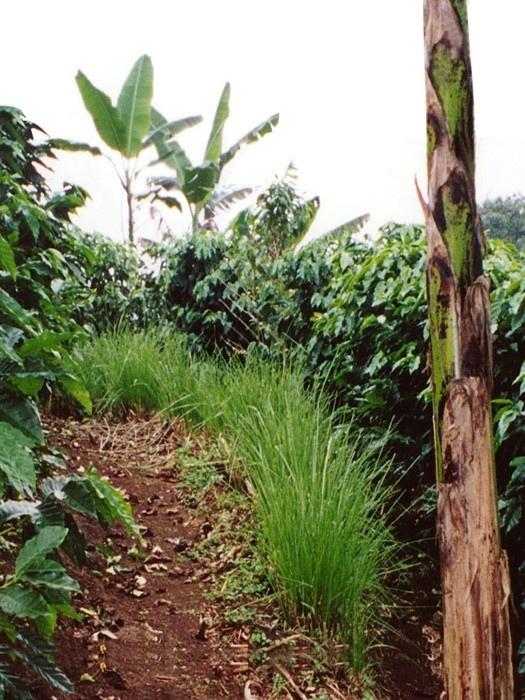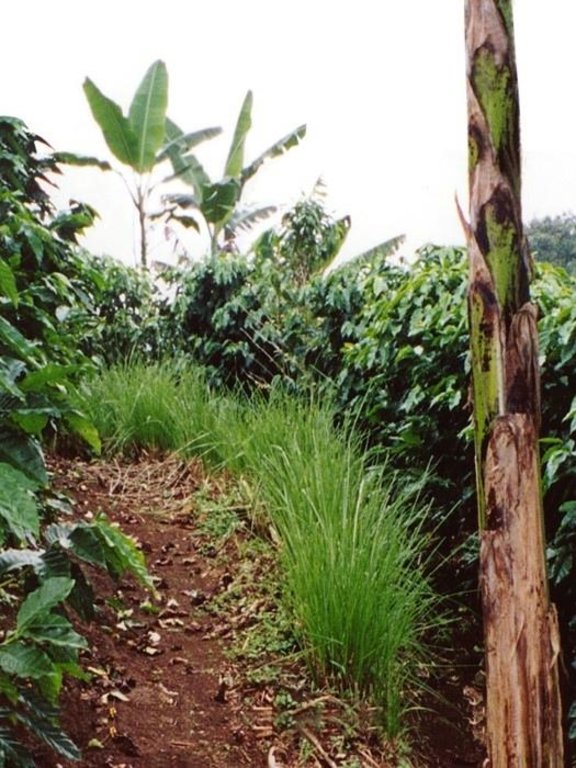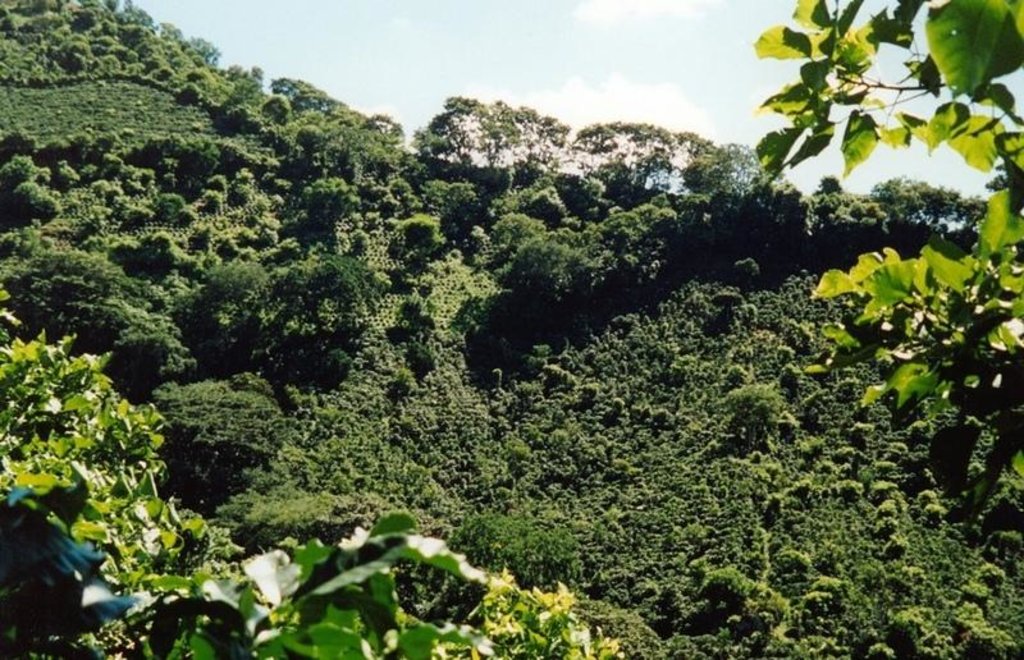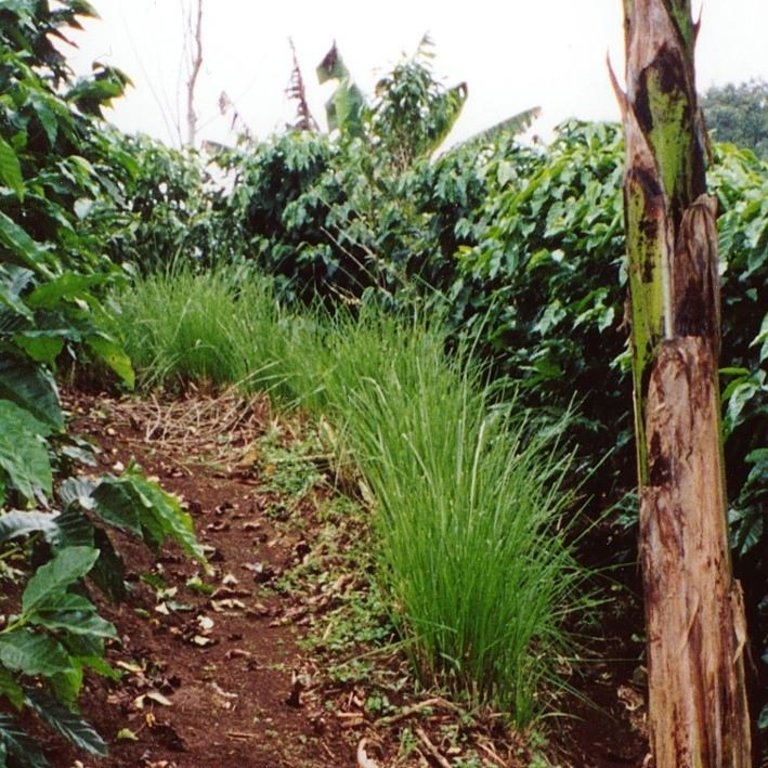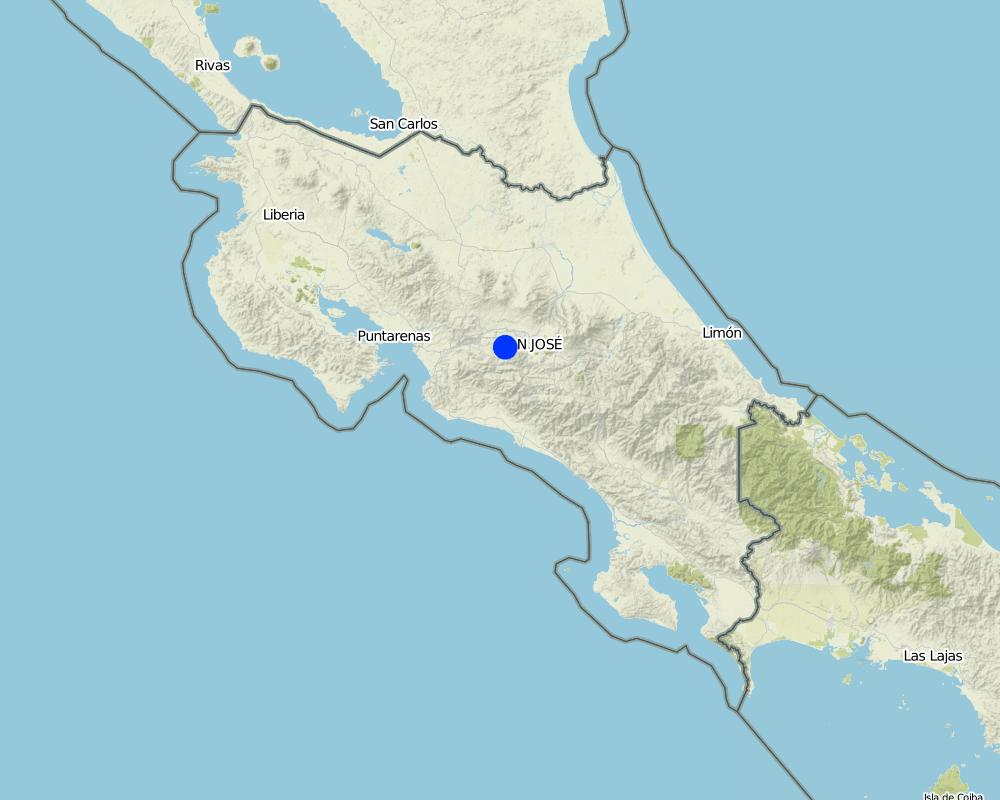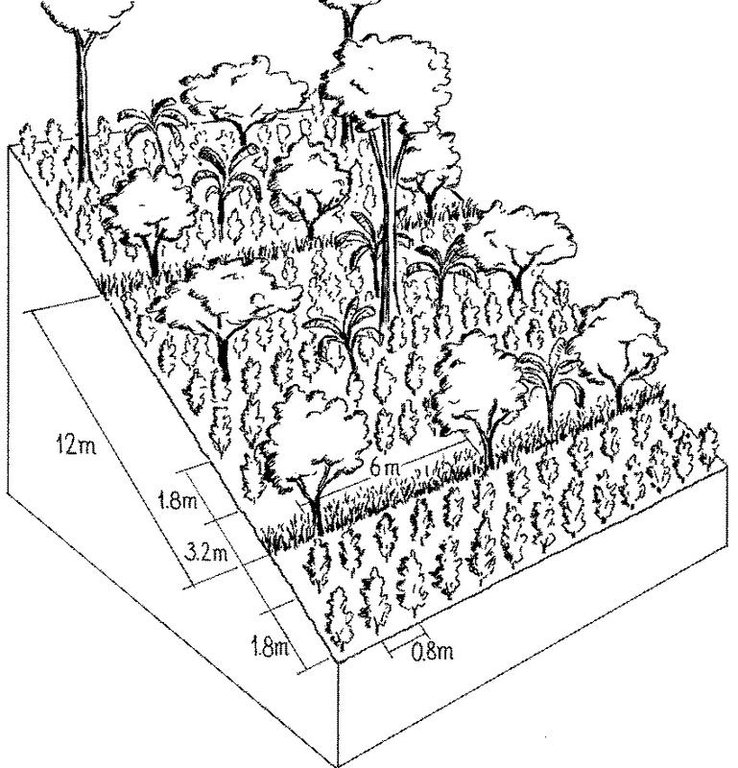Shade-grown coffee [ប្រទេសកូស្តារីកា]
- ការបង្កើត៖
- បច្ចុប្បន្នភាព
- អ្នកចងក្រង៖ Olman Quiros Madrigal
- អ្នកកែសម្រួល៖ –
- អ្នកត្រួតពិនិត្យ Deborah Niggli
Café arbolado (spanish)
technologies_1044 - ប្រទេសកូស្តារីកា
ពិនិត្យមើលគ្រប់ផ្នែក
ពង្រីកមើលទាំងអស់ បង្រួមទាំងអស់1. ព័ត៌មានទូទៅ
1.2 ព័ត៌មានលម្អិតពីបុគ្គលសំខាន់ៗ និងស្ថាប័នដែលចូលរួមក្នុងការវាយតម្លៃ និងចងក្រងឯកសារនៃបច្ចេកទេស
ឈ្មោះគម្រោងដែលបានចងក្រងឯកសារ/ វាយតម្លៃលើបច្ចេកទេស (បើទាក់ទង)
Book project: where the land is greener - Case Studies and Analysis of Soil and Water Conservation Initiatives Worldwide (where the land is greener)1.3 លក្ខខណ្ឌទាក់ទងទៅនឹងការប្រើប្រាស់ទិន្នន័យដែលបានចងក្រងតាមរយៈ វ៉ូខេត
តើពេលណាដែលទិន្នន័យបានចងក្រង (នៅទីវាល)?
01/08/2001
អ្នកចងក្រង និង(បុគ្គលសំខាន់ៗ)យល់ព្រមទទួលយកនូវលក្ខខណ្ឌនានាទាក់ទងទៅនឹងការប្រើប្រាស់ទិន្នន័យដែលបានចងក្រងតាមរយៈវ៉ូខេត:
បាទ/ចា៎
1.4 សេចក្តីប្រកាសស្តីពីចីរភាពនៃការពណ៌នាពីបច្ចេកទេស
តើបច្ចេកទេសដែលបានពណ៌នានេះមានបញ្ហាដែលផ្តោតលើការធ្លាក់ចុះគុណភាពដី, បើដូច្នេះវាមិនអាចត្រូវបានប្រកាសថាជាបច្ចេកទេសនៃការគ្រប់គ្រងប្រកបដោយចីរភាពទេ?
ទេ
1.5 ការយោងទៅលើកម្រងបញ្ជីសំណួរនៃវិធីសាស្ត្រផ្សព្វផ្សាយ SLM
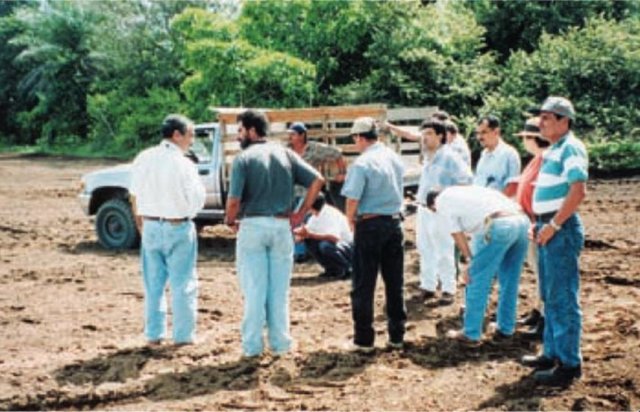
Agroforestry extension [ប្រទេសកូស្តារីកា]
Participatory extension of agroforestry systems, especially of shadegrown coffee, to promote sustainable and productive use of natural resources among small and medium scale farmers.
- អ្នកចងក្រង៖ Olman Quiros Madrigal
2. ការពណ៌នាពីបច្ចេកទេស SLM
2.1 ការពណ៌នាដោយសង្ខេបពីបច្ចេកទេស
និយមន័យបច្ចេកទេស:
An agroforestry system which combines coffee with shade trees - including fruit, timber and leguminous species - in a systematic fashion.
2.2 ការពណ៌នាលម្អិតពីបច្ចេកទេស
ការពណ៌នា:
Shade-grown coffee is a traditional and complex agroforestry system where coffee is associated with various other species in different storeys (or ‘levels’). This provides ecologically and economically sustainable use of natural resources. Café arbolado, the example promoted by PRODAF (Programme for Agroforestry Development, see related approach: ‘Agroforestry Extension’) since 1987 is one technical option for shade-grown coffee.
While based on a traditional system the shade-grown coffee technology has a specific layout, and a reduced number of intercropped species. It comprises: (1) Coffee (Coffea arabica) planted on the contour at approximately 5,000 plants per hectare; (2) Associated trees: fruits, most commonly oranges (120 trees/ha), cedar (Cedrela odorata) or caoba (Swietenia macrophylla) for timber (60 trees/ha) and also two legumes, poró (Erythrina poeppigiana) and chalum (Inga sp.) which act as shade trees and at the same time improve the soil by fixing nitrogen (60 trees/ha). Farmers often include bananas in the system. In some cases, orange trees have partly been substituted by avocado (Persea americana), soursop (Anona muricata), and/or jocotes (Spondias purpurea). The latter two command good market prices and do not compete with labour needed for harvesting and other activities; (3) Supportive soil conservation measures on steep slopes to avoid soil erosion, predominantly strips of lemon grass (Cymbopogon citratus) on the contour, retention ditches and soil cover improvement; (4) Fertilizers: both organic and inorganic combined.
Full establishment of a shaded coffee plot can be achieved in two years - after replanting trees which fail to establish. Coffee yields a harvest after two years, but timber from associated trees can be expected after only 25 years. The trees grown in association allow more efficient cycling of nutrients (because of deep rooting and nitrogen fixation) and provide a favourable microclimate for coffee. This production system is well adapted to the local biophysical and socio-economic conditions, characterised by steep erosion-prone mountain slopes, humid climate and small to medium scale agriculture. Based on café arbolado a new, and further developed system of ‘sustainable coffee’ has evolved. This involves certification of the overall process and is attractive to the growing number of environmentally conscious consumers.
2.3 រូបភាពនៃបច្ចេកទេស
2.5 ប្រទេស/តំបន់/ទីតាំងកន្លែង ដែលបច្ចេកទេសត្រូវបានអនុវត្ត និងបានគ្រប់ដណ្តប់ដោយការវាយតម្លៃនេះ
ប្រទេស:
ប្រទេសកូស្តារីកា
តំបន់/រដ្ឋ/ខេត្ត:
San José/Río Parrita
បញ្ជាក់បន្ថែមពីលក្ខណៈនៃទីតាំង:
Acosta-Puriscal
Map
×2.7 ការណែនាំពីបច្ចេកទេស
សូមបញ្ជាក់តើបច្ចេកទេសត្រូវបានណែនាំឱ្យអនុវត្តដោយរបៀបណា:
- តាមរយៈគម្រោង / អន្តរាគមន៍ពីខាងក្រៅ
3. ចំណាត់ថ្នាក់នៃបច្ចេកទេស SLM
3.1 គោលបំណងចម្បង (១ ឬច្រើន) នៃបច្ចេកទេសនេះ
- ធ្វើឱ្យប្រសើរឡើងនូវផលិតកម្ម
- កាត់បន្ថយ, បង្ការ, ស្តារឡើងវិញនូវការធ្លាក់ចុះគុណភាពដី
3.2 ប្រភេទដីប្រើប្រាស់មួយប្រភេទ (ច្រើនប្រភេទ) ដែលបានអនុវត្តបច្ចេកទេស

ចម្រុះ (ដំណាំ/ វាលស្មៅ/ ដើមឈើ)គិតទាំងកសិរុក្ខកម្ម
- កសិរុក្ខកម្ម
មតិយោបល់:
Major land use problems (compiler’s opinion): Severe deforestation, inappropriate land management practices (monocultures on steep slopes; lack of conservation measures); resulting in physical (soil erosion) and chemical (fertility decline) degradation of agricultural soils, low productivity and low yields.
3.3 ព័ត៌មានបន្ថែមអំពីអ្នកប្រើប្រាស់ដី
ការផ្គត់ផ្គង់ទឹកនៅកន្លែងអនុវត្តបច្ចេកទេស:
- ទឹកភ្លៀង
សូមបញ្ជាក់:
Longest growing period in days: 270, Longest growing period from month to month: Apr - Dec
3.4 ក្រុម SLM ដែលបច្ចេកទេសស្ថិតនៅក្នុង
- កសិរុក្ខកម្ម
3.5 ការសាយភាយនៃបច្ចេកទេស
មតិយោបល់:
Total area covered by the SLM Technology is 400 m2.
3.6 វិធានការ SLM ដែលបញ្ចូលនូវបច្ចេកទេស

វិធានការក្សេត្រសាស្ត្រ
- A1: ដំណាំ/គម្របដី

វិធានការរុក្ខជាតិ
- V1: ឈើធំៗ និងដើមឈើតូចៗ
- V2: ស្មៅនិងរុក្ខជាតិៗដែលដុះមានអាយុមិនលើសពី 2ឆ្នាំ
មតិយោបល់:
Type of agronomic measures: mixed cropping / intercropping
Type of vegetative measures: aligned: -contour
3.7 កំណត់ប្រភេទនៃការធ្លាក់ចុះគុណភាពដីសំខាន់ៗដែលបច្ចេកទេសនេះបានដោះស្រាយ

ការហូរច្រោះដីដោយសារទឹក
- Wt: ការបាត់ដីស្រទាប់លើដោយការហូរច្រោះ
- Wm: ការបាក់ដី

ការធ្លាក់ចុះសារធាតុគីមីក្នុងដី
- Cn: ការថយចុះជីជាតិ និងកាត់បន្ថយបរិមាណសារធាតុសរីរាង្គ (មិនកើតឡើងដោយការហូរច្រោះទេ)
មតិយោបល់:
Main causes of degradation: deforestation / removal of natural vegetation (incl. forest fires), over-exploitation of vegetation for domestic use, overgrazing, education, access to knowledge and support services (Falta de conocimientos), Falta de tecnología
Secondary causes of degradation: poverty / wealth (Falta de capital), Falta de fortaleza de legislación / de autoridad
3.8 ការពារ កាត់បន្ថយ ឬស្តារឡើងវិញនៃការធ្លាក់ចុះគុណភាពដី
បញ្ជាក់ពីគោលដៅរបស់បច្ចេកទេស ដែលផ្តោតទៅការធ្លាក់ចុះគុណភាពដី:
- ការការពារការធ្លាក់ចុះគុណភាពដី
4. បច្ចេកទេសជាក់លាក់ សកម្មភាពអនុវត្ត ធាតុចូល និងថ្លៃដើម
4.1 គំនូសបច្ចេកទេសនៃបច្ចេកទេសនេះ
4.2 លក្ខណៈពិសេសនៃបច្ចេកទេស/ ពណ៌នាពីគំនូរបច្ចេកទេស
Example layout of coffee grown below shade trees: various species are used for shade, and each has intrinsic value of its own - orange trees (for fruit) are associated with strips of lemon grass, tall cedars (for timber) are planted in rows alternating with Erythrina sp. (for fertility improvement). Optionally, banana trees are interplanted.
Technical knowledge required for field staff / advisors: high
Technical knowledge required for land users: high
Main technical functions: improvement of ground cover, increase in organic matter, increase of infiltration, increase in soil fertility
Secondary technical functions: control of raindrop splash, control of concentrated runoff, control of dispersed runoff
Agronomic measure: organic/chem. Fertilization
Aligned: -contour
Vegetative material: T : trees / shrubs
Number of plants per (ha): 60-120
Spacing between rows / strips / blocks (m): 12
Width within rows / strips / blocks (m): 6
Vegetative measure: grass strips
Vegetative material: G : grass
Spacing between rows / strips / blocks (m): 12
Vegetative measure: aligned shrubs
Vegetative material: G : grass
Number of plants per (ha): 5000
Spacing between rows / strips / blocks (m): 1.8
Width within rows / strips / blocks (m): 0.8
Vegetative measure: Vegetative material: G : grass
Trees/ shrubs species: poró (Erythrina poeppigiana), chalum (Inga spp.)
Fruit trees / shrubs species: Coffee, oranges, cedar or caoba for timber, bananas, oranges or avocado, soursop , and/or jocotes
Grass species: lemon grass (Cymbopogon citratus)
Structural measure: retention ditches (supp.)
4.4 សកម្មភាពបង្កើត
| សកម្មភាព | ប្រភេទវិធានការ | ពេលវេលា | |
|---|---|---|---|
| 1. | Clearing of land. | សារពើរុក្ខជាតិ | beginning of rainy season (March/April) |
| 2. | Surveying for contour planting of coffee, grass strips, trees etc. | សារពើរុក្ខជាតិ | beginning of rainy season (March/April) |
| 3. | Digging holes, fertilizer application. | សារពើរុក្ខជាតិ | beginning of rainy season (March/April) |
| 4. | Planting coffee, trees, grass barriers etc along the contour. | សារពើរុក្ខជាតិ | beginning of rainy season (March/April) |
| 5. | Replanting coffee that fails to establish in first year. | សារពើរុក្ខជាតិ | beginning of rainy season (March/April) |
4.5 ថ្លៃដើម និងធាតុចូលដែលត្រូវការសម្រាប់ការបង្កើតបច្ចេកទេស
| បញ្ជាក់ពីធាតុចូល | ឯកតា | បរិមាណ | ថ្លៃដើមក្នុងមួយឯកតា | ថ្លៃធាតុចូលសរុប | % នៃថ្លៃដើមដែលចំណាយដោយអ្នកប្រើប្រាស់ដី | |
|---|---|---|---|---|---|---|
| កម្លាំងពលកម្ម | labour | ha | 1,0 | 700,0 | 700,0 | 100,0 |
| សម្ភារៈដាំដុះ | Seedlings: poró/cedar | ha | 1,0 | 15,0 | 15,0 | |
| សម្ភារៈដាំដុះ | Seedlings: orange trees | ha | 1,0 | 220,0 | 220,0 | |
| សម្ភារៈដាំដុះ | Seedlings: coffee | ha | 1,0 | 1240,0 | 1240,0 | |
| ជី និងសារធាតុពុល | fertilizer | ha | 1,0 | 350,0 | 350,0 | |
| ផ្សេងៗ | transport | ha | 1,0 | 10,0 | 10,0 | |
| ថ្លៃដើមសរុបក្នុងការបង្កើតបច្ចេកទេស | 2535,0 | |||||
មតិយោបល់:
Duration of establishment phase: 24 month(s)
4.6 សកម្មភាពថែទាំ
| សកម្មភាព | ប្រភេទវិធានការ | ពេលវេលា/ ភាពញឹកញាប់ | |
|---|---|---|---|
| 1. | Fertilization | ក្សេត្រសាស្ត្រ | May, July, November / 1–3 times |
| 2. | Pest control (spraying) | ក្សេត្រសាស្ត្រ | May, September / 1–2 times |
| 3. | Application of lime. | ក្សេត្រសាស្ត្រ | |
| 4. | Pest control (spraying) | ក្សេត្រសាស្ត្រ | May, September / 1–2 times |
| 5. | Application of lime. | ក្សេត្រសាស្ត្រ | |
| 6. | Weed control | សារពើរុក្ខជាតិ | Weed control |
| 7. | Pruning coffee | សារពើរុក្ខជាតិ | February or March / |
| 8. | Pruning shade trees. | សារពើរុក្ខជាតិ |
4.7 កំណត់ថ្លៃដើមសម្រាប់ការថែទាំ/ សកម្មភាពរបស់បច្ចេកទេស (ក្នុងរយៈពេលមួយឆ្នាំ)
| បញ្ជាក់ពីធាតុចូល | ឯកតា | បរិមាណ | ថ្លៃដើមក្នុងមួយឯកតា | ថ្លៃធាតុចូលសរុប | % នៃថ្លៃដើមដែលចំណាយដោយអ្នកប្រើប្រាស់ដី | |
|---|---|---|---|---|---|---|
| កម្លាំងពលកម្ម | labour | ha | 1,0 | 28,0 | 28,0 | 100,0 |
| ជី និងសារធាតុពុល | fertilizer | ha | 1,0 | 175,0 | 175,0 | 100,0 |
| ផ្សេងៗ | transport | ha | 1,0 | 127,0 | 127,0 | 100,0 |
| ថ្លៃដើមសរុបសម្រាប់ការថែទាំដំណាំតាមបច្ចេកទេស | 330,0 | |||||
មតិយោបល់:
Machinery/ tools: shovel, machete, knapsack
The costs of planting coffee are included. Shade-grown coffee is an integrated production system, and thus costs for coffee and the agroforestry component cannot be disaggregated.
5. លក្ខណៈបរិស្ថានធម្មជាតិ និងមនុស្ស
5.1 អាកាសធាតុ
បរិមាណទឹកភ្លៀងប្រចាំឆ្នាំ
- < 250 មម
- 251-500 មម
- 501-750 មម
- 751-1,000 មម
- 1,001-1,500 មម
- 1,501-2,000 មម
- 2,001-3,000 មម
- 3,001-4,000 មម
- > 4,000 មម
តំបន់កសិអាកាសធាតុ
- សើម
Thermal climate class: tropics
5.2 សណ្ឋានដី
ជម្រាលជាមធ្យម:
- រាបស្មើ (0-2%)
- ជម្រាលតិចតួច (3-5%)
- មធ្យម (6-10%)
- ជម្រាលខ្ពស់បន្តិច (11-15%)
- ទីទួល (16-30%)
- ទីទួលចោត (31-60%)
- ទីទួលចោតខ្លាំង (>60%)
ទម្រង់ដី:
- ខ្ពង់រាប
- កំពូលភ្នំ
- ជម្រាលភ្នំ
- ជម្រាលទួល
- ជម្រាលជើងភ្នំ
- បាតជ្រលងភ្នំ
តំបន់តាមរយៈកម្ពស់ :
- 0-100 ម
- 101-500 ម
- 501-1,000 ម
- 1,001-1,500 ម
- 1,501-2,000 ម
- 2,001-2,500 ម
- 2,501-3,000 ម
- 3,001-4,000 ម
- > 4,000 ម
5.3 ដី
ជម្រៅដីជាមធ្យម:
- រាក់ខ្លាំង (0-20 សម)
- រាក់ (21-50 សម)
- មធ្យម (51-80 សម)
- ជ្រៅ (81-120 សម)
- ជ្រៅខ្លាំង (> 120 សម)
វាយនភាពដី (ស្រទាប់លើ):
- មធ្យម (ល្បាយ, ល្បាប់)
- ម៉ត់/ ធ្ងន់ (ឥដ្ឋ)
សារធាតុសរីរាង្គនៅស្រទាប់ដីខាងលើ:
- ខ្ពស់ (>3%)
- មធ្យម (1-3%)
5.6 លក្ខណៈនៃអ្នកប្រើប្រាស់ដីដែលអនុវត្តបច្ចេកទេស
ទីផ្សារនៃប្រព័ន្ធផលិតកម្ម:
- ពាក់កណ្តាលពាណិជ្ជកម្ម (ផ្គត់ផ្គង់ខ្លួនឯង/ ពាណិជ្ជកម្ម
ចំណូលក្រៅកសិកម្ម:
- 10-50% នៃចំណូល
កម្រិតប្រើប្រាស់គ្រឿងយន្ត:
- ប្រើកម្លាំងពលកម្ម
សូមបញ្ជាក់ពីលក្ខណៈពាក់ព័ន្ធផ្សេងទៀតអំពីអ្នកប្រើប្រាស់ដី:
Off-farm income specification: subdivision of land (through inheritance), improved communications linking the capital with rural areas, and a better system of education all provide for increased off-farm income earning opportunities
5.7 ទំហំផ្ទៃដីជាមធ្យមនៃដីផ្ទាល់ខ្លួន ឬជួលគេដែលបានអនុវត្តបច្ចេកទេស
- < 0.5 ហិកតា
- 0.5-1 ហិកតា
- 1-2 ហិកតា
- 2-5 ហិកតា
- 5-15 ហិកតា
- 15-50 ហិកតា
- 50-100 ហិកតា
- 100-500 ហិកតា
- 500-1,000 ហិកតា
- 1,000-10,000 ហិកតា
- > 10,000 ហិកតា
5.8 ភាពជាម្ចាស់ដី កម្មសិទ្ធប្រើប្រាស់ដី និងកម្មសិទ្ធប្រើប្រាស់ទឹក
ភាពជាម្ចាស់ដី:
- ឯកជន មិនមានកម្មសិទ្ធ
- ឯកជន មានកម្មសិទ្ធ
កម្មសិទ្ធិប្រើប្រាស់ដី:
- ឯកជន
6. ផលប៉ះពាល់ និងការសន្និដ្ឋាន
6.1 ផលប៉ះពាល់ក្នុងបរិវេណអនុវត្តបច្ចេកទេសដែលកើតមាន
ផលប៉ះពាល់លើសេដ្ឋកិច្ចសង្គម
ផលិតផល
ផលិតកម្មដំណាំ
មតិយោបល់/ ការបញ្ជាក់:
coffee, about 10% less than in conventional systems (per ha per year)
ផលិតកម្មឈើ
ចំណូល និងថ្លៃដើម
បន្ទុកការងារ
ផលប៉ះពាល់ទៅលើវប្បធម៌សង្គម
ស្ថាប័នជាតិ
ផលប៉ះពាល់ទៅលើអេកូឡូស៊ី
ដី
សំណើមដី
គម្របដី
ការបាត់បង់ដី
ការកាត់បន្ថយហានិភ័យនៃគ្រោះមហន្តរាយ និងគ្រោះអាកាសធាតុ
ល្បឿនខ្យល់
6.2 ផលប៉ះពាល់ក្រៅបរិវេណអនុវត្តបច្ចេកទេសដែលកើតមាន
ទឹកជំនន់ខ្សែទឹកខាងក្រោម
6.4 ការវិភាគថ្លៃដើម និងអត្ថប្រយោជន៍
តើផលចំណេញ និងថ្លៃដើមត្រូវបានប្រៀបធៀបគ្នាយ៉ាងដូចម្តេច (ទស្សនៈរបស់អ្នកប្រើប្រាស់ដី)?
រយៈពេលខ្លី:
អវិជ្ជមាន
រយៈពេលវែង:
វិជ្ជមាន
តើផលចំណេញ និងការថែទាំ/ ជួសជុលត្រូវបានប្រៀបធៀបគ្នាយ៉ាងដូចម្តេច (ទស្សនៈរបស់អ្នកប្រើប្រាស់ដី)?
រយៈពេលខ្លី:
វិជ្ជមាន
រយៈពេលវែង:
វិជ្ជមានខ្លាំង
6.5 ការទទួលយកបច្ចេកទេស
មតិយោបល់:
100% of land user families have adopted the Technology with external material support
There is a little trend towards spontaneous adoption of the Technology. There is a slight trend towards growing spontaneous adoption - after the end of the programme. However, the crisis triggered by the big drop in coffee prices has had a negative impact on adoption of the technology. Many coffee farms have been abandoned specially those located under 800-900 m a.s.l. where coffee is of a lower quality due to climatic conditions.
6.7 ភាពខ្លាំង/ គុណសម្បត្តិ/ ឱកាសនៃបច្ចេកទេស
| ភាពខ្លាំង/ គុណសម្បត្តិ/ ឱកាស ទស្សនៈរបស់បុគ្គលសំខាន់ៗ |
|---|
| Increased overall crop production and diversity: coffee, fruit, timber, legumes |
| Different crops harvested at different periods, gives better distribution of labour (and income) throughout the year; participation of all family members; increased food security and minimal economic risk |
| Improved profitability. |
| More efficient use of nutrients, nitrogen fixation, lower inputs of fertilizers. |
| Increased pest resistance, lower external inputs of biocides. Coffe plants continue to produce over 25 years due to optimal microclimate (only 15 years in conventional system without trees). Production system adapted to steep erosion prone slopes, thus a productive alternative to simple afforestation. Not labour-intensive compared with structural measures of SWC. High commercial potential of environmentally friendly produced coffee due to new market trends. Price increase for agricultural inputs has favoured a shift from conventional to shade-grown coffee, the latter being a system with a higher ratio of applied inputs/harvested yields although total production is usually lower than in modern coffee plantations. |
6.8 ភាពខ្សោយ/ គុណវិបត្តិ/ ហានិភ័យនៃបច្ចេកទេស និងវិធីសាស្ត្រដោះស្រាយ
| ភាពខ្សោយ/ គុណវិបត្តិ/ ហានិភ័យ ទស្សនៈរបស់អ្នកចងក្រងឬបុគ្គលសំខាន់ៗ | តើបច្ចេកទេសទាំងនោះបានដោះស្រាយបញ្ហាដូចម្តេច? |
|---|---|
| Slight decrease in production of coffee per hectare compared to the conventional pure stand | Compensate by additional benefits: wood production, fruit, etc. |
| Short-term negative cost-benefit ratio in the first 4–5 years: Costintensive technology in the establishment phase. | Identify fast growing species or species providing intermediate products. |
| Timber harvest only in the long term (after 25 years) |
7. ឯកសារយោង និងវេបសាយ
7.1 វិធីសាស្ត្រ/ ប្រភពនៃព័ត៌មាន
- តាមការចុះទីវាល ការស្រាវជ្រាវនៅទីវាល
- ការសម្ភាសន៍ជាមួយអ្នកប្រើប្រាស់ដី
7.2 ឯកសារយោងដែលបានចេញផ្សាយ
ចំណងជើង អ្នកនិពន្ធ ឆ្នាំ ISBN:
PRODAF . Sistema agroforestal – Café arbolado, Ecología y economía para el progreso, Puriscal, Costa Rica. 1994.
ចំណងជើង អ្នកនិពន្ធ ឆ្នាំ ISBN:
Neuenschwander E . Agorforstwirtschaftlicher Kaffeeanbau als Lösungsansatz für eine ökologisch nachhaltige Bodennutzung der Hanglagen inCosta Rica: eine Fallstudie im Rahmen des WOCAT Programms, unpublished MSc thesis. 2002.
មានប្រភពមកពីណា? ថ្លៃដើមប៉ុន្មាន?
Science Faculty, University of Berne, Centre for Developmentand Environment
ការតភ្ជាប់ និងម៉ូឌុល
ពង្រីកមើលទាំងអស់ បង្រួមទាំងអស់ការតភ្ជាប់

Agroforestry extension [ប្រទេសកូស្តារីកា]
Participatory extension of agroforestry systems, especially of shadegrown coffee, to promote sustainable and productive use of natural resources among small and medium scale farmers.
- អ្នកចងក្រង៖ Olman Quiros Madrigal
ម៉ូឌុល
គ្មានម៉ូឌុល


